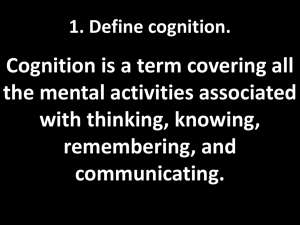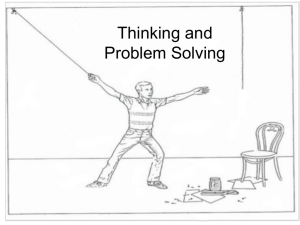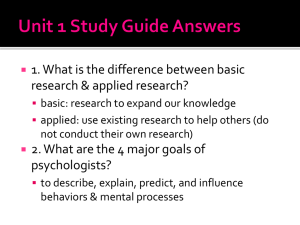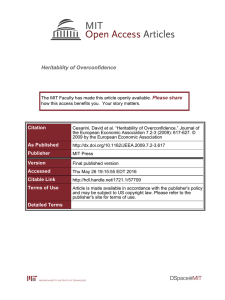EC989 Behavioural Economics Sketch solutions for Class 3 Neel Sagar
advertisement
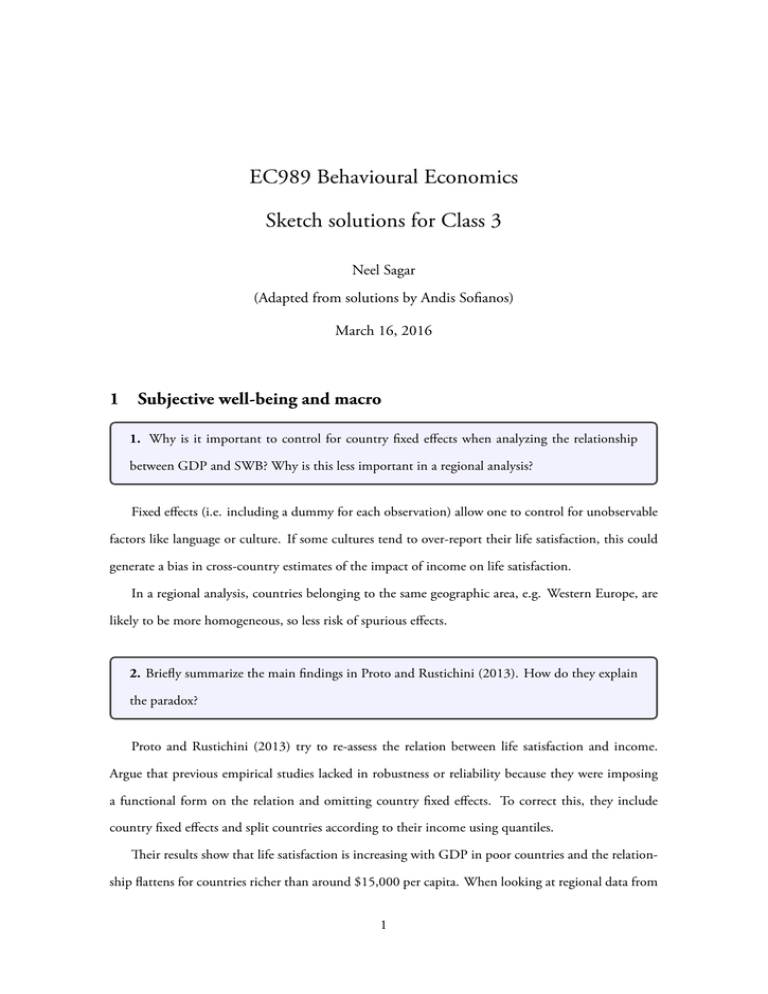
EC989 Behavioural Economics Sketch solutions for Class 3 Neel Sagar (Adapted from solutions by Andis Sofianos) March 16, 2016 1 Subjective well-being and macro 1. Why is it important to control for country fixed effects when analyzing the relationship between GDP and SWB? Why is this less important in a regional analysis? Fixed effects (i.e. including a dummy for each observation) allow one to control for unobservable factors like language or culture. If some cultures tend to over-report their life satisfaction, this could generate a bias in cross-country estimates of the impact of income on life satisfaction. In a regional analysis, countries belonging to the same geographic area, e.g. Western Europe, are likely to be more homogeneous, so less risk of spurious effects. 2. Briefly summarize the main findings in Proto and Rustichini (2013). How do they explain the paradox? Proto and Rustichini (2013) try to re-assess the relation between life satisfaction and income. Argue that previous empirical studies lacked in robustness or reliability because they were imposing a functional form on the relation and omitting country fixed effects. To correct this, they include country fixed effects and split countries according to their income using quantiles. Their results show that life satisfaction is increasing with GDP in poor countries and the relationship flattens for countries richer than around $15,000 per capita. When looking at regional data from 1 cities in Western Europe, they find that there appears to be an income ’bliss point’ of around $3033,000. They also find that these effects are moderated positively by Extraversion, and negatively by Neuroticism. They explain this by proposing that life satisfaction is made up of relative and absolute income effects. The absolute income effect dominates for poorer countries. As countries get richer, the relative income gets stronger until it eventually cancels out the absolute effect. 3. Are the results in the paper, di Tella et al. (2001) consistent with the existence of a welfare function depending on inflation and unemployment? What is the cost of unemployment, when compared to the cost of inflation? The evidence suggests that an individual’s welfare function does depend on inflation and unemployment. A percentage point increase in unemployment lowers life satisfaction by 2 points, but inflation lowers life satisfaction by only 1.4. Hence, unemployment appears to be more costly to welfare than inflation. 2 Non-standard beliefs 1. What do Burks et al. (2013) argue about the effect of social signalling on overconfidence? The study by Burks et al. (2013) investigates the psychological mechanisms that generate overconfident judgements. To do so, they recruited 1068 trainee truck drivers. Stages of study: 1. Predict the quantile of group performance in which their test scores would fall. 2. Two tests of cognitive ability: (1) Raven and (2) Adult Test of Quantitative Literacy (Numeracy Test) – involves reading text samples and solving arithmetic problems that are based on the text. 3. Second self-assessment of quantile after completion of the test. 4. Fill out MPQ - a standard personality profile test consisting question on 11 different scales. (wellbeing, social potency, achievement, social closeness, stress reaction, alienation, aggression, control, harm avoidance, traditionalism and absorption.) 2 5. Choose whether to be told their score and which quantile their performance was in when payment is given. This is meant to measure demand for information about their relative performance. Participants appear to be over-confident about their performance. Very few rate their ability in the bottom 40% of the ability distribution, while above 60% of participants think they are in the top 40% - consistent with past literature on overconfidence. Overconfidence is widespread across all ability levels and is still present in the self-assessment given after test completion. A lot more evidence of overconfidence than underconfidence. They test 3 theories to explain the results: 1. Bayesian updating, where individuals don’t know their true type 2. Self image - only intrinsic 3. Self image related to other people’s impressions of you - Social Signalling 1. Fails because according to the Bayesian model, the modal quantile chosen by participants must be the true one. This is rejected by the data. 2. Intrinsic self image is composed of consumption value (getting direct utility from thinking you are good), and motivation value (being motivated to exert more effort in future if you think you are good). If this was the reason for overconfidence, people with higher quantile beliefs about their score should be less likely to want to reveal their true results. However, the results show the opposite is true. 3. The authors formulate a model of social signalling. Individuals are assumed to misstating their beliefs in a motivated way to present a positive image to the outside world. If maintaining a rational expectations assumption, this theory necessarily requires heterogeneity among individuals in how much they care about what others thinks of them. If all individuals had the same incentives to overstate their abilities, a rational outside world would never infer anything from these statements. They conclude that when costs of lying are small but positive, lower ability types would lie to signal that they are better than they actually are. This lie might be a cognitive bias where your brain is lying to itself, rather than a conscious decision to lie. Social dominance appears to pick up important differences in the overconfidence of judgements while being unrelated to actual abilities. Social closeness scale shows no differences, hence, the relation3 ship is only limited to the aspect of dominance relative to others. Regarding the stress-reaction scores, individuals highly sensitive to social stress have more timid judgements about their ability. Hence, social signalling as whole seems to be very relevant in explaining overconfidence. 2. With reference to Conlin et al. (2007), why is the fact that people are over-influenced by the weather at the time they make decisions evidence for the existence of projection bias? Projection bias is where people systematically misestimate the magnitude of a stimulus on their utility. Weather is often quite volatile, even though average weather conditions are usually predictable. If people place a lot of weight on current weather in longer term decisions, they would be overweighting its effect on their utility. This would be evidence of projection bias. 3. How do they test this, and what are their main hypotheses/results? Conlin et al (2007) show this using data from a mail order catalogue that sells cold weather clothing/equipment. They had two main hypotheses: 1. Likelihood of returning orders falls as the temperature on the day of the order increases 2. Likelihood of returning orders rises as the temperature on the day of receipt increases The first hypothesis was found to hold. A 30◦ F decrease in temperature on the order date led to a 3.95% increase in returns (which was significant). However, the second hypothesis was not found to hold in the data. This is likely because decisions regarding the return of the item may not have taken place on the same day the order was received. A limitation of the study was that it could be argued what they found is actually a bias in the ability to predict weather, rather than a bias in predicting utility effects. There is no way in their study that they could distinguish which one was the true cause. 4


